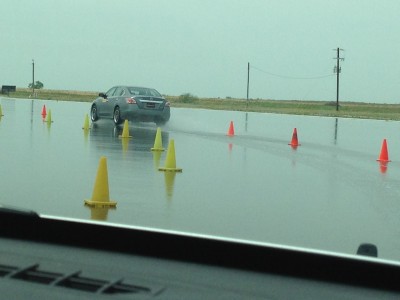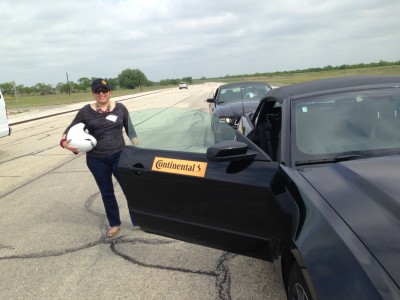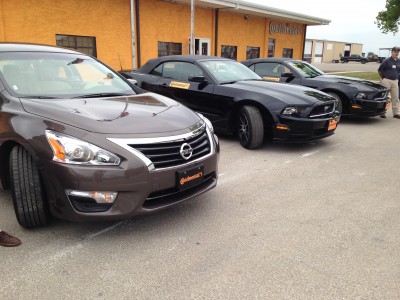Confessions of a Cheapskate: Learning Why Tire Tread Matters

I have a confession to make: I have really cheap tires on my car. Really cheap.
Every time I pull up to a stop sign I have to allow an extra 20 or 30 feet to stop or I might go flying through the intersection. And, my tires are new. This is only the start to my confessions of a cheapskate, and my wake up call that tire treads save lives. We’ve only put a few thousand miles on them and already, we need new tires.
I took the safety of my car for granted: it meets or exceeds safety standards and has always driven great. Until we made what we thought was a money-saving move. I have started to realize, though, that I don’t really have that much control, that I have to brake earlier and can’t drive as fast as I used to on these tires.
I learned just how much control we can have over the drive experience recently when I was invited by Continental Tires to test out their new True Contact tire in Uvalde, Texas.
During our day on the test track. we first drove on bald tires. Uually when I’m driving on bald tires, I’m given a stern, unapproving look by a mechanic trying to sell me new ones (I really hate that).

Testing tires on Continental’s wet track: good tires will hold the road in the rain, poor tires will allow the car to slide
Now I know the difference, not because I can tell by looking or dipping a penny into the tire tread, but by how the car stops or responds when there’s water on the road. Which is really what you want, because how often do you really think to get down on your knees and check out your tread? It’s when you’re sliding through a curve and your kids turn ghostly white from the experience that you think, hey, maybe I should have my tires checked.
How Do You Know the Difference? You Can Feel it Behind the Wheel
Good tires will stop quickly. Bald tires won’t. Good tires will shed water and maintain traction with the road. Bald tires won’t. Good tires will let you hug the curves of a road, and drive faster through them; bald tires will slide through curves.
To me, knowing this is more important than knowing that tread depths, or the depth of the deep channels that separate the solid bands of rubber on your tires, should be 4/32nds of an inch or more.
Huh? To put that in more visual terms, 4/32nds of depth is about 3 millimeters. Look at a ruler; that’s not much. 2/32nds, which is the legal minimum in many states (below this your tires would fail inspection) is even less. If you’re driving on 2/32nds of tread depth, you’re basically skating around on a hard rubber surface. That definitely changes the safety of your tires.
The Tires = Shoes Analogy: This Has Happened To You, Right?
Think of it this way: walking across a parking lot in sneakers, with thick soles of ziz-zagging rubber treads, you can feel the rubber gripping the pavement. But walking across the same parking lot in ballet flats with a hard plastic sole, you have to be careful; one step on a pebble or a crack can send you flying. You’ve been there, right?
Just like that sneaker, your tires grip the pavement. The more they grip the pavement, the more they help your car stay on course, stop on command and protect you from rain or snow. In order to grip the pavement, they need a thick tread, just like your sneaker.
The Secret To Good Tires
During our test track experience we tried out several different brands of tires, some new, some worn to 4/32nds of an inch and some worn to 2/32nds of an inch; here are some things we learned:
- New tires with a full tread depth have about 11/32nds of tread, vs. 4/32nds, which is deemed unsafe.
- Full tread depth means you can stop more quickly on both wet and dry roads.
- The new tires we tested stopped at about 135 feet on wet pavement; the bald tires stopped about 180 feet. The difference is about the length of a city bus. That means if you have to slam on the brakes, bald tires will take you an extra length of a city bus to stop (the Continental Tires team certainly took a breath of relief when the True Contact tires got the best stopping distance: 124 feet).
- That extra distance means that if your tires are bald, you should be driving slower—20 miles an hour slower; or, that’s how much faster you can go and take the same distance to stop on good tires vs. bald.
- The new tires we tested also allowed us to go faster on wet roads. We slalomed and curve-hugged our way around the course. With the True Contact tires we could hit 40 MPH around a curve and spare the orange cones; on the bald tires, even 30 MPH around the same curve resulted in some small orange casualties.
- Tire tread is important on wet roads because it allows the water to travel up through the tread and away from the road; in essence it absorbs the water rather than letting the tire skate on top of it.
How Do Your Tires Compare?
Test the stopping distance of your tires: Some place safe, such as a safe road or an empty parking lot, note where you apply the brakes, and when you’ve stopped, get out and measure how far it took you to stop (pace it off, about three steps to a yard). Or, pick a point on the road and start to count as you pass it and hit the brakes: one Mississippi, two Mississippi, three Mississippi; each count of Mississippi is a second; good tires stop you at 15 feet per second, so how many seconds would it take you to stop? How far did you go?
Video courtesy of Continental Tires and shot by Justin Noe.
Now, you know the difference between good tires and bad ones, too. You can learn more about how to choose the right tire, how to decode the numbers on tires and the different types of tires here. So when you go to the tire store, or you are faced with the snarky smirk of an arrogant mechanic trying to sell you new tires, you can ask intelligent questions and have an informed opinion. Then, be sure to ask him the difference between tinted moisturizer and BB cream. Just so you can return the snarky smirk.
Continental brought a group of us—including Jenny On the Spot, Jessica Gottlieb, Morgan Shanahan, April McCormick, Yoly Mason and Kristen Howerton of RageAgainstTheMinivan— to test out the True Contact tires, which were developed for us: SUV and minivan drivers who carry the world’s most precious cargo in the backseat. These tires were developed for larger cars carrying larger loads, and their specific talent is to shed water away from the tire, keeping traction high. And the way they let us drive on the track—fast, furious and fun—taught us not only the value of good tires, but the value of learning to challenge our sensibilities behind the wheel. Now, it’s off to the tire store to best the salesman with my knowledge and finally, put good tires on my car.
Disclosure: Continental provided my transportation and accommodations to test out their tires. Opinions expressed here, as well as the giggles, squeals, and delightful flood of adrenaline as we drove around the test track, are all my own.


